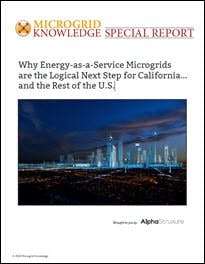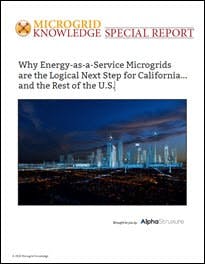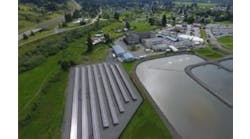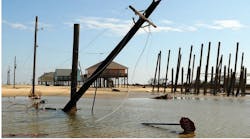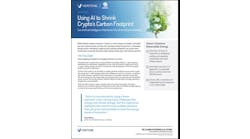California often serves as a bellwether, and now it’s ringing an alarm about a new electric grid vulnerability. As other states brace for the impact of climate change, they watch California’s wildfires and power shutoffs and wonder what’s in store for them. A new special report from Microgrid Knowledge and AlphaStruxure explores energy-as-a-service microgrids as a solution.
When Superstorm Sandy knocked out power to eight million electric customers on the eastern seaboard in 2012, it underscored the vulnerability of the traditional electric grid. And since then, a series of additional natural disasters and equipment failures have driven home the lesson.
Download the full report.
Some examples of the largest power outages include:
- A derecho in June 2012 left 4.4 million customers in the Mid-Atlantic and Ohio Valley without power, some for nine days
- Hurricane Irma cut power to two-thirds of Florida, 6.7 million electricity customers, in September 2017
- Equipment failure knocked out power to the world’s busiest airport, Hartsfield-Jackson Atlanta, for 11 hours on Dec. 17, 2017, costing Delta Airlines as much as $50 million
- Hurricane Maria caused the longest blackout in U.S. history, starting in September 2017 and extending for nearly a year for some areas of Puerto Rico
- Earthquakes in Puerto Rico again plunged the island into darkness in January 2020
These incidents are the headline grabbers. But every day somewhere in the U.S. power fails because of weather, accidents, equipment malfunctions or other causes. The costs of these outages vary based on their length and who they affect. But to get a sense of their impact, Esource looked at eight major industries and found that outages as short as four hours cost on average $10,000 to $20,000 per business.
How California changed the way we think about power outages
But the wildfires of 2019 turned conventional power outage scenarios on their head. With utility wires and equipment sparking deadly and destructive wildfires, this time the utility was not tasked with bringing the power back, but with shutting it down.
A microgrid is a self-sufficient energy system that serves a discrete geographic footprint, such as business complex, campus or community. During a power outage, the microgrid islands from the utility grid and its onsite resources provide power to its host buildings.
To avert fires, California utilities conducted what they call public safety power shutoffs. Power lines were de-energized, and millions of customers in October and November 2019 had no electric service, sometimes for days. The power outages disrupted business, closed schools and endangered those reliant on medical equipment. The lack of traffic lights led to car accidents. Without refrigeration food perished in homes, stores and restaurants. Retail operations that could not operate cash registers closed their doors. Telecommunications became spotty. A society deeply dependent on the Internet found chaos in navigating its daily business.
The power shutoffs dealt a considerable blow to California’s economy. The Stanford Woods Institute for the Environment estimated that the economic cost associated with just one power shutdown affecting 800,000 customers for 48 hours could reach $2.5 billion.
While hurricanes, earthquakes, floods and tornadoes
have been chief perpetrators of widespread US power outages in the past, an even more devastating foe has emerged in California: wildfires. (Photo Fsmelo/Shutterstock.
In response to the shutoffs, some in California turned to backup diesel generators. However, this isn’t a viable solution. With some of the most ambitious climate change legislation in the world, California is seeking to phase out fossil fuels. The state faces these pressures as it also grapples with electricity costs that are among the highest in the nation.
And while California is the current region of concern about wildfires, it is not the only vulnerable state. Others face their own accelerating climate pressures, sustainability mandates, declining reliability and increasing costs.
Why we published this paper
Microgrids offer a way to keep the electricity flowing to all elements of society. But they are not being installed quickly enough to avert broad economic hardship from major power outages. Why the delay? Many electric customers remain unaware of the technology. Others mistakenly believe microgrid costs put them out of reach.
Microgrid Knowledge has partnered with AlphaStruxure, a joint venture of Schneider Electric and The Carlyle Group, to publish this report in hopes of bridging the education gap. We focus, in particular, on energy-as-a-service microgrids, the no-money down model that allows electric customers to reap the reliability, economic and environmental benefits of microgrids without capital outlay or operational risk.
Stay tuned. This special report series will also explore in the coming weeks:
- Why microgrids are at an inflection point
- What businesses and institutions need to consider as they make decisions about energy costs, reliability and sustainability
- How energy-as-a-service contracts work and real-world examples
We invite you to download, “Why Energy-as-a-Service Microgrids are the Logical Next Step for California…and the Rest of the U.S,” free of charge, courtesy of AlphaStruxure. And we encourage you to share this link widely to help educate California — and the rest of the U.S. — about energy-as-a-service microgrids.
